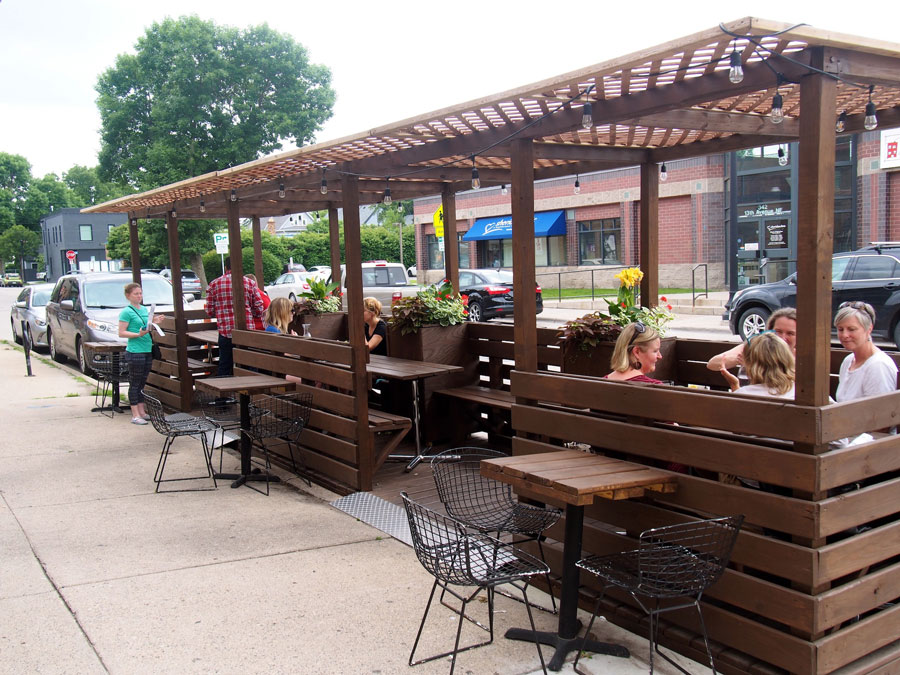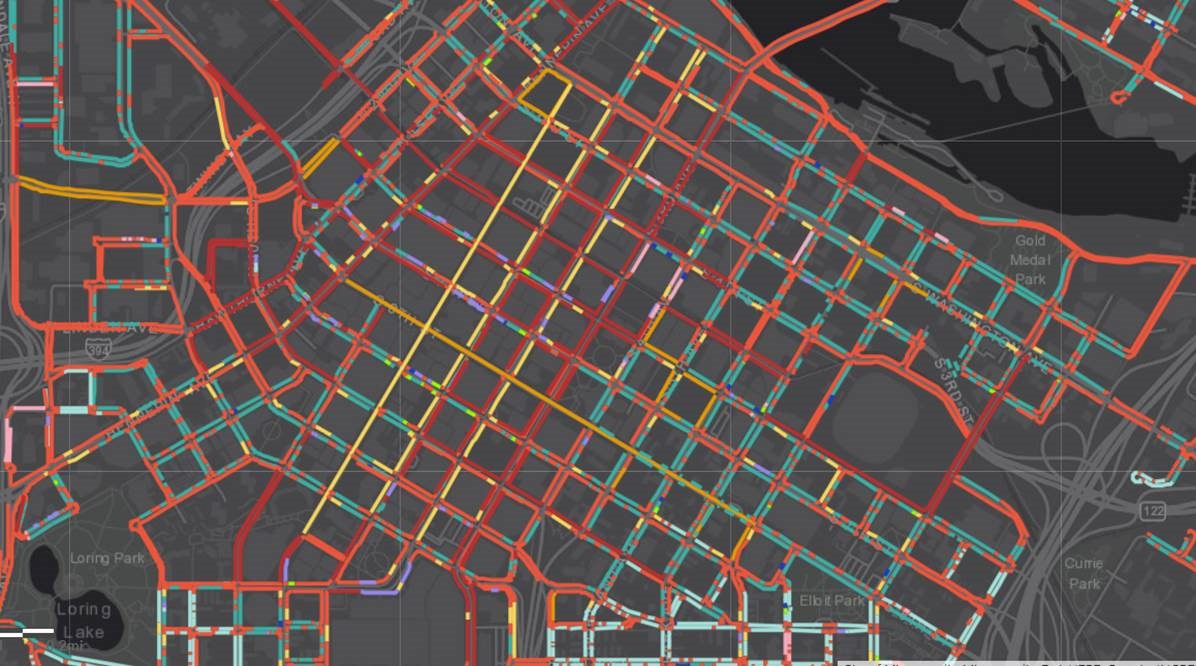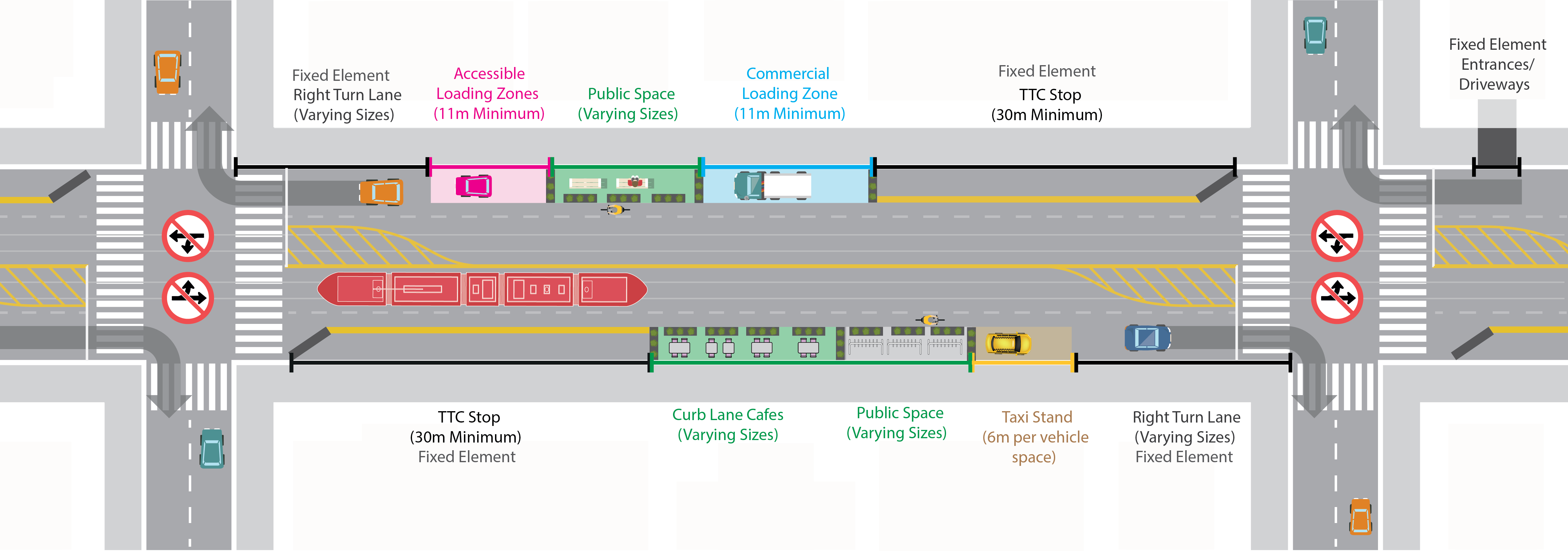Strategy 5 Price and manage use of the curb to encourage walking, biking and using transit, and to discourage driving alone.
The actions within this strategy are divided into two categories:
Action we will DOActions we will SUPPORTAction we will do are followed by “DO” and are colored in dark gray, and actions we will support are followed by “SUPPORT” and are colored in light gray.
Learn more about how we get thereDuring public engagement, we asked a question about ranking the importance of uses typically accommodated along the curb. The results show that people understand the multiple demands for curbside use beyond the typical parking uses. All these uses, and the careful consideration of the opportunity cost of the curb, are necessary to evaluate when implementing new ways of managing the curb.
Past decisions have rendered much of the public right of way available for the travel and storage of private vehicles at little cost, the increasing demands and opportunities for the space forces the City to reconsider how this space is allocated and accessed. How space is allocated, what access exists for who and at what cost, will guide the use of the City’s streets.
Minneapolis has 8,330 on-street metered parking spaces that are priced for at least part of the day.1 Approximately 32 miles, or 3% of the miles in the city are metered. Comprehensively evaluating the opportunity to extend where and how curbs are priced through modernized ordinances is a specific action outlined below (3.1.2) with a large potential to align practices more accurately with our transportation goals and Complete Streets Policy.
Cornerstone to this strategy is the development of a curbside management policy. The City will manage the curb in a way that reflects our goals and supports advancements in mobility. A concrete way this will happen is to create flexible curbside space for different uses, including loading and unloading of people (on transit or in shared or private cars) and goods, storage of all types of vehicles, and mobility spaces (transit and bike lanes).
- Minneapolis Parking
Actions to price and manage use of the curb to encourage walking, biking, and using transit, and to discourage driving alone.
Street Operations 5.1
Adopt a strong curbside management policy that takes full advantage of a dynamic urban environment; prioritize the curb in alignment with the City’s Complete Streets Policy and value the competing demands for curb space.
Supported goals:
Mobility
Related actions:
Difficulty:
Low
Timeframe:
2020-2023 (Years 0-3)
Street Operations 5.2
Develop a multi-purpose dynamic curb zone pilot for multiple corridors to accommodate all users and develop a revenue structure which charges across modes for use of these zones.
Supported goals:
Mobility
Related actions:
Transit 2.6, Freight 5.5
Difficulty:
High
Timeframe:
2024-2027 (Years 4-7)
Street Operations 5.3
Modernize ordinances to incentivize desired uses through pricing structure – for example, to encourage use of curbside for parklets and other street activation uses or shared, electric vehicles.
Supported goals:
Prosperity Mobility
Related actions:
Technology 1.1, Technology 1.2, Technology 1.3, Technology 1.4, Technology 1.5, Technology 1.6, Technology 1.7, Technology 1.8, Technology 1.9, Technology 1.10, Technology 1.11
Difficulty:
Low
Timeframe:
2020-2023 (Years 0-3)
Street Operations 5.4
Utilize technology along commercial corridors and within downtown and other commercial areas to manage all curbside uses.
Supported goals:
Prosperity Mobility
Related actions:
Technology 1.1, Technology 1.2, Technology 1.3, Technology 1.4, Technology 1.5, Technology 1.6, Technology 1.7, Technology 1.8, Technology 1.9, Technology 1.10, Technology 1.11
Difficulty:
High
Timeframe:
2028-2030 (Years 8-10)
Street Operations 5.5
Employ on-street and off-street parking strategies to support transit corridors (parking maximums for new developments, facilitated shared parking incentives, dynamic pricing, expanded metered parking).
Supported goals:
Climate Equity Mobility
Related actions:
Difficulty:
High
Timeframe:
2024-2027 (Years 4-7)
Street Operations 5.6
Investigate implementation of a per trip fee for applicable curbside uses including delivery and shared mobility services.
Supported goals:
Mobility
Related actions:
Difficulty:
High
Timeframe:
2024-2027 (Years 4-7)
Street Operations 5.7
Study congestion pricing with the intent to discourage single occupancy vehicle trips.
Congestion pricing is a tool to manage the volume of motor vehicles entering certain zones by charging a fee during a set period of the day or week.
Supported goals:
Mobility
Related actions:
Difficulty:
High
Timeframe:
2028-2030 (Years 8-10)
Street Operations 5.8
Pursue legislative changes and governmental support needed to make car sharing more attractive.
Supported goals:
Mobility
Related actions:
Technology 2.6
Difficulty:
High
Timeframe:
2020-2023 (Years 0-3)
Status:
On-going
Street Operations 5.9
Price on-street parking meters to support multimodal street operations and mode share goals.
Supported goals:
Mobility
Related actions:
Difficulty:
Medium
Timeframe:
2020-2023 (Years 0-3)
Status:
On-going
Street Operations 5.10
Evaluate whether meters or priced curb space should be expanded to more corridors.
Supported goals:
Mobility
Related actions:
Difficulty:
Medium
Timeframe:
2020-2023 (Years 0-3)
Status:
On-going
Street Operations 5.11
Assign and mark typical block faces in downtown to flexibly assign space for activation or placemaking, on-street bicycle or scooter parking, passenger and freight loading, drop off/pick up, and standard vehicular storage zones, where immediate adjacent curbside space is not used for bike or transit mobility.
Supported goals:
Mobility
Related actions:
Bicycles 9.1
Difficulty:
High
Timeframe:
2024-2027 (Years 4-7)
Street Operations 5.12
Continue the process of digitizing the activities on the curb (parking, loading, etc.), and plan for digital communication between the curb and vehicles.
Placemaking – or activation – refers to using street as shared public spaces for people.
Supported goals:
Mobility
Related actions:
Difficulty:
High
Timeframe:
2020-2023 (Years 0-3)
Street Operations 5.13
Partner with Move Minneapolis to recruit downtown employers and property owners to increase walking, biking and transit use among their employees and residents.
Supported goals:
Active Partnerships
Related actions:
Difficulty:
Medium
Timeframe:
2028-2030 (Years 8-10)
Street Operations 5.14
Manage off-street parking supply, demand and pricing in downtown. Partner with others in pursuit of City policies, including the reduction of single occupancy vehicle use.
Supported goals:
Climate Equity Active Partnerships
Related actions:
Difficulty:
Medium
Timeframe:
2020-2023 (Years 0-3)
Status:
On-going


